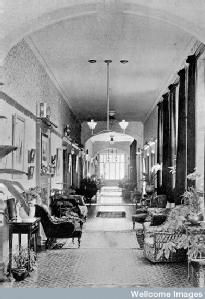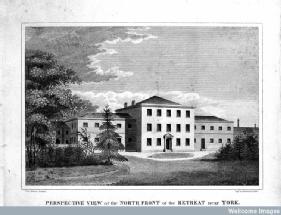Reform, Moral Management and the York Retreat
TOPIC 4 (WEEK 5): INTRODUCTION
QUESTIONS
-
How did the Tukes arrive at their system of moral treatment and how was this put into practice at the York Retreat?
-
Did the York Retreat mark a 'revolution' or a continuing trend in approaches to the treatment of insanity?
-
How would you evaluate the rationale, significance and success of moral treatment?
-
Was the introduction of moral management a purely progressive development?
- Did Bethlem stand for 'bad' and the Retreat as 'good' in terms of asylum care?
DOCUMENTS
READING
MORAL MANAGEMENT AND REFORM
KEY READING: Read 2-3 of the following chapters or articles, marked **
**Roy Porter, Mind-Forg’d Manacles: A History of Madness in England from the Restoration to the Regency (London: Athlone, 1987; Penguin edn, 1990), ch.4. Multiple copies in library and e-book
**Anne Digby, ‘Changes in the Asylum: The Case of York, 1777-1815’, Economic History Review, 2nd series, 37 (1983), 218-39 (a useful discussion of the York Asylum, i.e. not The Retreat). e-journal
**Anne Digby, 'The Changing Profile of a Nineteenth-Century Asylum: The York Retreat’, Psychological Medicine, 14 (1984), 739-48. e-journal
**Barry Edginton, 'Moral Architecture: The Influence of the York Retreat on Asylum Design', Health and Place, 3 (1997), 91-99. e-journal
**Andrew Scull, ‘Moral Treatment Reconsidered: Some Sociological Comments on an Episode in the History of British Psychiatry’, in Madhouses, Mad-Doctors, and Madmen, pp.105-20. e-book
FURTHER READING:
Roy Porter, Madmen: A Social History of Madhouses, Mad-Doctors and Lunatics (Stroud: Tempus, 2004), ch. 4.
*Anne Digby, ‘Moral Treatment at the Retreat, 1796-1846’, Anatomy of Madness II, pp. 52-72.
* Anne Digby, Madness, Morality and Medicine: A Study of the York Retreat (Cambridge University Press, 1985).
Akihito Suzuki, ‘The Politics and Ideology of Non-Restraint: The Case of the Hanwell Asylum’, Medical History, 39 (1995), 1-17.
e-journal
Louise Wannell, 'Patients' Relatives and Psychiatric Doctors: Letter Writing in the York Retreat, 1875-1910', Social History of Medicine, 20 (2007), 297-313. e-journal
Jonathan Andrews et al., The History of Bethlem (London and New York: Routledge, 1997), ch. 23, ‘Bethlem and the 1815 Select Committee’. ch. 23.
William F. Bynum, ‘Rationales for Therapy in British Psychiatry, 1780-1835’, in Madhouses, Mad-Doctors, and Madmen, pp. 35-57. e-book
Vieda Skultans, English Madness: Ideas on Insanity 1580-1890 (London: Routledge & Kegan Paul, 1979), ch. 4 ‘The Moral Managers’, pp. 52-68.
Michel Foucault, Madness and Civilization: A History of Insanity in the Age of Reason (London: Tavistock, 1967, or other editions), ch. 9 ‘The Birth of the Asylum’. e-book, multiple copies in library or buy on Amazon
Dora B. Weiner, ‘”Le geste de Pinel”: The History of a Psychiatric Myth’, in Micale and Porter, Discovering, pp. 232-47.
INTRODUCTION TO ASYLUMS: HISTORIOGRAPHY
**Jonathan Andrews, ‘The Rise of the Asylum in Britain’, in Deborah Brunton (ed.), Medicine Transformed: Health, Disease and Society in Europe 1800-1930 (Manchester University Press, with the Open University, 2004), pp. 298-330. Multiple copies in library and available via Talis
**Roy Porter, ‘Madness and Its Institutions’, in Andrew Wear (ed.), Medicine in Society (Cambridge University Press, 1992), pp. 277-301. e-book
*Andrew Scull, The Most Solitary of All Afflictions: Madness and Society in Britain, 1700-1900 (Yale University Press, 1993), chs 2-4. Multiple copies in library
Roy Porter, ‘Shaping Psychiatric Knowledge: The Role of the Asylum’, in Roy Porter (ed.), Medicine in the Enlightenment (Amsterdam and Atlanta, GA: Rodopi, 1995), pp. 255-73. Multiple copies in library
Leonard D. Smith, ‘Cure, Comfort and Safe Custody’: Public Lunatic Asylums in Early Nineteenth-Century England (Leicester University Press, 1999) OR Leonard D. Smith, Lunatic Hospitals in Georgian England, 1750-1830 (New York: Routledge 2007). e-book
*Roy Porter, ‘Madness and Society in England: The Historiography Reconsidered’, Studies in History, 3 (1987), 275-90. e-journal
*Andrew Scull, ‘The Domestication of Madness’, Medical History, 27 (1983), 233-48. e-journal


